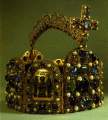personal union, league, estate, sedria, chairs
| |
|
The relation of countries independent of one another, which are connected through the person of the ruler. Its counterpart is the real union, which means the real communion of countries. The borders of personal and real unions are not defined exactly, and these notions were not used in the Middle Ages. For example, Hungary was in a personal union with Croatia from the end of the 11th century until 1918, from 1370 to 1382 and 1440 to 1444 with Poland, from 1410 to 1439 with the Holy German-Roman empire, from 1420 to 1457 and 1490 to 1526 with the Czech state and from 1438 to 1457 with Austria.
IT
league (Latin alliance)
The name of the alliance of political groups in a state or among states. In Hungary it means the alliance of baron families in the Sigismund- and Hunyadi age. They made formal, written alliances several times, for example, on the question of succession to the throne, receiving important honours, giving away estates and mutual marriages.
IT
estate
1. An expression for social groups from early Middle Ages through the 17th century. Today's equivalents are class, layer, group; it was replaced by the word class in the 19th century. 2. Social groups with members who have the same rights. The place of the members in a social hierarchy is defined by either their birth, education or profession. 3. Socail groups which have the same rights in the late Middle Ages in Europe, which were represented at the meetings of the parliament.
IT
sedria (Latin sedes iudiciaria = court)
The name of county courts from the 13th century, where most of the activities of the medieval county was performed. In most of the cases they passed judgement on villeins, who were then entitled to appeal to the landlord. In matters effecting noblemen they were allowed to judge only in lesser cases or to make investigations under judicial orders. Sedrias were usually held every second week, the same day and at the same place. In some counties there were two sedrias Their permanent members were the ispán [bailiff] (who rarely took part in the meetings personally), the deputy ispán(s), magistrates and the clerk.
IT
chairs
Units of local governments in the territory of castle districts, which were outside the power of the authorities. They were formed in the 14th century near the border of the country and at places which were populated later. Their organisation - just like that of the counties - was not from 'under', but from 'above', from the central power. The majority of the Székelys and Saxons, as well as the Cumans and the Jász-s had their own chairs. Sometimes the ten-spear district of the Szepes was also called a chair.
IT

